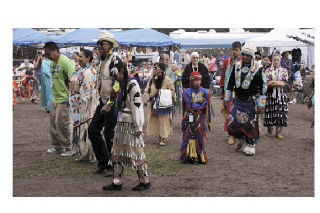ARLINGTON — The 19th annual Stillaguamish Festival of the River offered onlookers its characteristic mix of environmental education and relaxed entertainment in the summer sun, Aug. 9-10, at the River Meadows County Park.
Much of the event’s diversity was reflected in the festival’s pow wow, which boasted dozens of dancers, representing nearly as many Native American tribes across the country.
The festival’s organizers also hoped to impart to their guests a greater awareness of the local land and its issues. Pat Stevenson, environmental manager for the Stillaguamish Tribe, pointed out that the primary purpose of the festival has always been to promote the needs of the area’s watershed among its residents.
“They need to know about the state of the fish and wildlife populations and the water quality, not just here, but in other parts of the Puget Sound region,” Stevenson said. “As the urban sprawl develops and cities like Arlington and Stanwood grow, we’re shedding our forests.”
Stevenson encouraged local citizens to take their surrounding environment into account, at home and at work, by adopting personal responsibility for the land and conserving water usage whenever they’re able to do so.
“Especially if you live on the west side, you shouldn’t worry so much about watering your lawn, because it’s going to rain,” Stevenson said. “Also, remember that the chemicals you use as pesticides and herbicides tend to get into the stream. Pets can contribute to a lot of the bacteria, because some of their owners think that if their dogs go to the bathroom outside, it just disappears. It ends up in the creek.”
City of Arlington Natural Resources Director Bill Blake agreed with Stevenson that the festival adds to the general public’s knowledge, not only of the steps they can take to protect and restore the watershed, but also of the groups and resources that are available to aid them in such aims.
“It gives property owners a chance to meet the workers who help maintain the watershed, not so much as members of agencies, but as people,” Blake said. “We inform them of the work we do and how we do it. With the aerial maps in our booths, we can show them the names of the creeks and streams they’re living around and tell them what species are native to those areas.”
Blake asserted that interactive features such as the “salmon obstacle course” for children and the logging show for all ages could further personalize environmental issues that might otherwise seem dry or distant to some spectators.
“In the salmon obstacle course, kids have to make their way through a path of fishing nets, species of predators and other barriers, with only a few safe havens of logjams to protect them,” said Blake of the staked-off loop of signs, nets and pipes. “Even when adults see it, a light bulb turns on in their head about how difficult it is for these fish to survive. In much the same way, the logging show lets the loggers display skills they use in the field.”
The music stage hosted performances from bands such as Smashmouth, the Gin Blossoms, the English Beat, the Knack, and Leroy Bell and His Only Friends.
In the midst of tents of arts and crafts vendors, and stands selling salmon, frybread, snow-cones and homemade ice cream, the festival’s dual themes of Native American heritage and environmental stewardship were echoed in almost all of its exhibits.
David Pehling, a Snohomish County extension assistant for Washington State University, has fascinated festival audiences for more than a decade with his demonstrations of “flint knapping,” chipping away at arrowheads using the techniques and tools that were common to the ancient ancestors of Native and non-Native Americans alike.
“Kids in general often get interested in it, especially boys about 10-14 years old, but there are a lot of bigger kids who stay interested,” said Pehling, clad in traditional Native American garb and telling tales from inside his own teepee. “I’m part of a Puget Sound area group of flint knappers with members in their 60s and 70s. They become intrigued by these artifacts from another culture and want to learn how to create the same things.”
The Sarvey Wildlife Center, an Arlington-based non-profit organization devoted to the care and rehabilitation of injured and orphaned wild animals, brought a parliament of owls and other birds to the festival, while soliciting donations.
“This is definitely one of our biggest outreach programs,” Stevenson said. “Throughout the year, we get phone calls from citizens about various projects or problems, as a result of the connections that the locals make and the interactions they have with the Tribe at this festival.”








